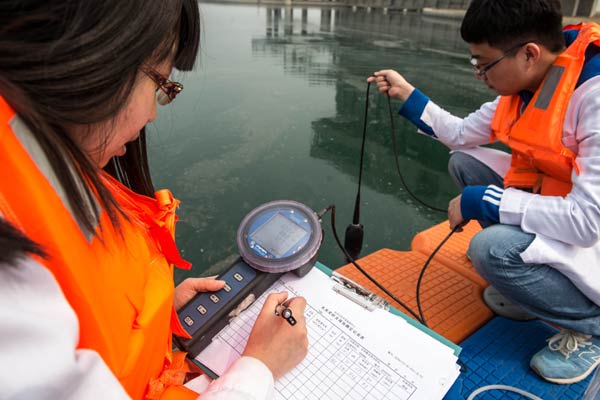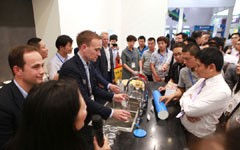 |
|
Workers with the South-to-North Water Diversion Project test a water sample from a reservoir in Beijing's Fengtai district. Water quality and the impact of pollution on rivers and lakes are said to be causing growing public concerns.ZHANG YU/XINHUA |
Chinese, US students join hands to setup new platform for quality awareness
University students in the United States and those from Chinese business schools have established a crowd-sourcing platform to help people in China learn more about the quality of the water they use every day.
The Web portal, called MyH2O (myh2o.org), is one of the first online crowdsourcing platforms in China aiming to promote risk awareness, citizen activism and governmental response through independent reports on water quality.
The team is made up of Chinese students studying at such American universities as the Massachusetts Institute of Technology and Columbia University, and MBA students at the Cheung Kong Graduate School of Business in Beijing.
Similar to air quality apps that provide detailed, updated indicators about the air in cities across China, MyH2O allows individuals to look at data about the water they use, including heavy metal indicators, pH value, risk warnings and filtering recommendations. Users may purchase water-testing kits from the website as well.
 |
 |
"A lot of news stories and literature about the severity of water pollution in China were too vague and general for individuals to be able to get an idea about the quality of the water they use," said Charlene Ren, an engineering student at MIT. "A public portal to test and share water quality information is needed to help the public learn more about their water. With that goal, we began to plan our project, MyH2O, so everybody has access to understanding and improving their water quality."
"The mapping and data visualization components of MyH2O involve an innovative technique for delivering fieldwork results to the general public in an illustrative format," said Natalie Cong, an MBA student at CKGSB.
"By typing in a simple address, the website will take the user to a vivid summary page, including overall ratings and weighted averages of each available water quality parameter based on how it compares to health standards and the rest of the country's data. They can click on each parameter to learn more about its health implications and see what remedial measures (such as using filters) can be taken."
Fieldwork is a crucial part of building a comprehensive database for MyH2O. So the team is now crowdsourcing universities for the equipment and commitment to do the tests in China.
"We are covering a few regions in suburban Beijing as a test run," said Ren. "The experiences obtained from this test will be written into a water-testing guidance booklet."
The purpose of the field test is to analyze data to understand key pollution concerns and potential causes, and eventually to give recommendations to community members about water sanitation and safety based on real data in the area, Ren said.
In the winter, MyH2O will choose a Chinese university where it will put together its own team to run tests in Luanping, Hebei province.
Next summer, the website will invite a call for proposals from universities across China in specific regions they are interested in to conduct water quality field tests. Five to 10 university groups will be selected. Each will then conduct tests in at least 100 regions, which will produce statistics from approximately 500 to 1,000 regions.
"Eventually, more and more universities across China will join in the effort and make the field test a routine practice all over China," Ren said, "especially in areas where there is no piped waterline."
This public welfare initiative has garnered the support of business school students who have an awareness of corporate social responsibility.
"When I came across the water initiative led by students at MIT, I contacted them immediately to offer my assistance from a business school perspective and to help spread the word through my network," said Jeremy Solomons, an MBA student at CKGSB. "I believe social innovation and social entrepreneurship are now of key importance for the well-being of society and future generations."
"Team members from the business school pushed us to think about our value propositions and revenue channels," Ren said. "They helped us create a stronger and clearer model of operation that has grown to become much more practical and appealing."
